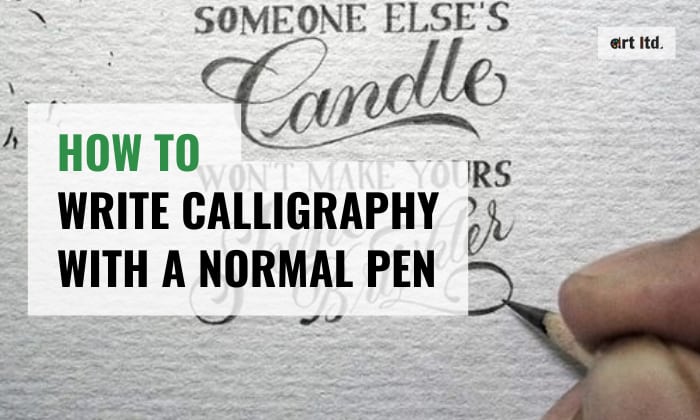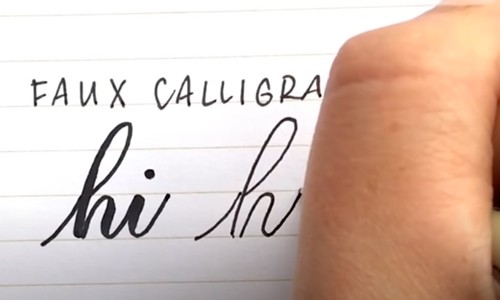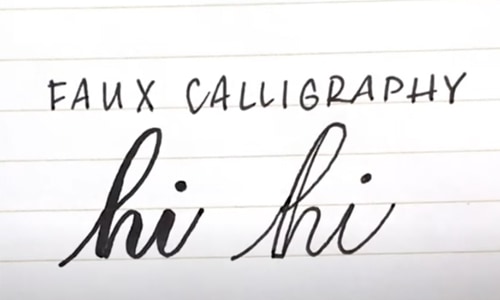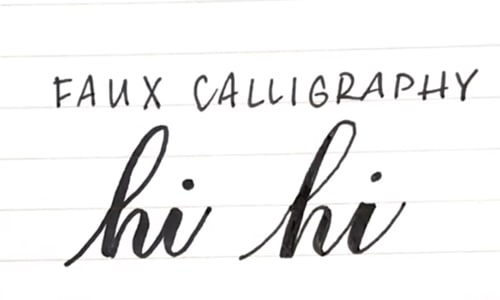Calligraphy, the art of writing and lettering, is a fascinating skill many people want to learn. However, the conventional calligraphy tools, such as nibs, ink, and brushes, can be expensive and difficult to master, especially for beginners.
The good news is that with a simple pen and some basic techniques, you can create stunning calligraphy pieces that impress your friends and family.
How to write calligraphy with a normal pen? With our detailed tutorial, you can achieve beautiful results. So grab a pen and let’s start this exciting journey of calligraphy writing!
Table of Contents
A Step-by-step Guide to Writing Calligraphy With a Normal Pen
What to Prepare
Our instruction requires some simple equipment. You will need a regular pen, a piece of paper, a pencil, and an eraser. Any type of pen will do. Be it ballpoint pens, gel pens, felt tip pens, or even fountain pens.
If you’re a beginner, you should select a pen with a consistent ink flow and a tip suitable for creating thin and thick lines. It’s best to look for pens with a felt tip or a nib that can produce a range of line widths.
In order to achieve the best results, you’ll also need to be familiar with some basic calligraphy techniques. Three crucial ones to master are:
- Sketching with a pencil before using a pen
- Forming letters with a regular pen based on the basic strokes
- Creating both thick and thin strokes in your writing
Step 1: Use A Pen To Write The Word
To start doing faux calligraphy from A to Z with a normal pen. You can use a pencil or regular pen to write your words. Using a pencil will be easier to correct mistakes.
Remember to leave enough space between the letters to add thickness to the downstrokes in the next step.
When writing your word, take your time and write slowly and carefully to ensure the strokes are even. It will make it easier to thicken the word and create a polished look.
Step 2: Add Thickness to The Word
Use a fine-tipped pen to carefully trace over the downstrokes in your cursive calligraphy handwriting, making the traced lines slightly wider than the original strokes.
To do this, draw a line parallel to the downstroke, connecting it to the initial lines. This will create a space between the outlined strokes.
When doing ballpoint pen calligraphy, apply extra pressure on the lines when you write to make them thicker.
Remember that you can create downstrokes in any direction you want as long as the outline and thickness of the words are equal.
Using this technique, you can achieve the look of calligraphy with a regular pen, allowing for more flexibility and control in your writing.
Step 3: Fill In The Outline
Fill in the outline shape with your regular pen. Try to make the filling as evenly as possible to look clean and polished.
Keep your pen strokes in the same direction to avoid uneven ink stains or smudges from the outline. You can also erase any pencil marks that are still visible.
Note: Be patient and take time when adding thickness to the downstrokes. Rushing can result in uneven lines, making your fake calligraphy look messy.
You can refer to this video for more details: How to do Faux Calligraphy with a Normal Pen for Beginners #fauxcalligraphy #calligraphytutorial
Tips and Tricks for Improving Your Calligraphy Skills
Potential challenges or mistakes beginners might encounter include not following calligraphy basics and not paying attention to posture.
Other errors include inconsistent letter shapes and choosing the wrong pen. In addition, writers may be too hasty when writing calligraphy and sometimes feel bored. To avoid these mistakes:
- Practice regularly: Like any other skill, calligraphy requires regular practice to improve. Set aside time each day or week to practice your calligraphy, even just a few minutes.
- Pay attention to your posture: Sitting up straight and holding your pen at the correct angle can make a big difference in your calligraphy.
Make sure you are comfortable and holding your pen correctly to prevent hand cramps and other issues.
- Use the right tools: Make sure you use the right pens and paper for your calligraphy.
Experiment with different pens and nibs to find what works best for you. The high-quality paper (Canson marker, Rhodia paper, etc.) that is smooth and absorbent can also help improve your calligraphy.
- Start with basic strokes: Practice basic strokes like thin upstrokes and thick downstrokes before moving on to fully write calligraphy letters. It will help you build muscle memory and improve your technique.
- Study calligraphy writing styles: Look at examples of styles you admire and try replicating them. Pay attention to the letter shapes, spacing, and flow of the writing.
- Be Patient: Calligraphy requires patience and precision. Going too fast can lead to mistakes and messy results.
Thus, focus on the details of each letter of the calligraphy alphabet, such as the shape, thickness, and spacing. It can help you to create more consistent and beautiful calligraphy.
FAQs
What Is The Difference Between Calligraphy And Handwriting?
|
Calligraphy |
Handwriting |
|
● Focuses on creating beautiful lettering and designs. ● Calligraphers usually use specific tools and techniques to create intricate and ornate lettering, often with flourishes, and varying stroke widths. ● Often used for formal documents (invitations, certificates, other special occasions) ● Used for artistic purposes, such as creating artwork, poetry, or other written expressions. |
● Refers to the way a person writes by hand naturally. ● Writers can use any regular pen to handwriting without any special tools or techniques. ● Often used for practical purposes, such as taking notes, writing letters, or filling out forms.
|
Can I Practice Calligraphy On Any Type Of Paper?
Yes. You can practice calligraphy on any paper.
However, the ideal paper for calligraphy should be smooth, have dense fibers and a slight texture that allows the ink to adhere to the surface without feathering or bleeding.
The best papers are printer paper, Rhodia Dotpad, Southworth Linen, and Cardstock paper.
How Long Does It Take To Learn Calligraphy?
In general, it can take several months to a year of regular practice to become proficient in calligraphy.
- A beginner can expect to spend 2-3 hours to 2 months just learning the basics of calligraphy.
- If you want to master it, you’ll need over a year of ongoing practice and refinement.
Besides, the time to learn calligraphy can vary widely depending on the individual’s natural talent, level of dedication, and the complexity of the calligraphy style they are learning.
Can I Write Gothic Calligraphy With A Fountain Pen?
Yes, you can write Gothic calligraphy with a wide-nib fountain pen. It can create fine lines with varying widths.
When choosing a fountain pen for Gothic calligraphy, look for one with a flexible nib that can easily create thick and thin lines.
Some fountain pens come with interchangeable nibs that can be swapped to achieve different line widths.
Conclusion
How to write calligraphy with a normal pen? You just need to write the word, outline the thickness, and fill in it. Using a normal pen can produce impressive calligraphy with the right amount of practice and patience.
Remember to choose the right paper and use consistent pressure to achieve the desired results.
Whether you are a beginner or an experienced calligrapher, doing calligraphy with a pen can be a fun and rewarding experience that allows you to express your creativity in a unique and elegant way.

Art has always been a part of my life; it influences my upbringing and later my career choice. For me, it is always a part of my parenting technique. So for whichever purpose that you come to art, you can start here with us.




